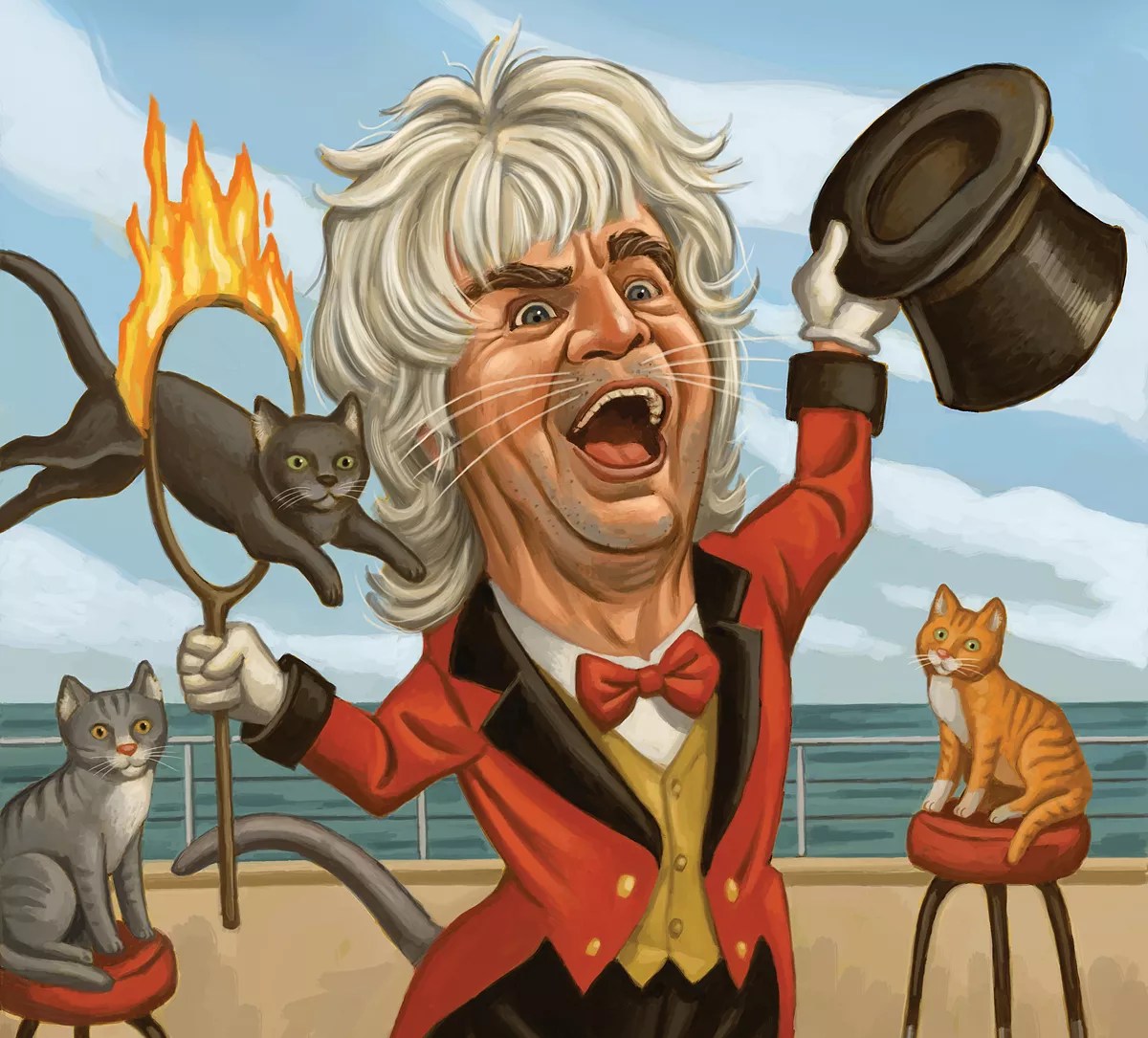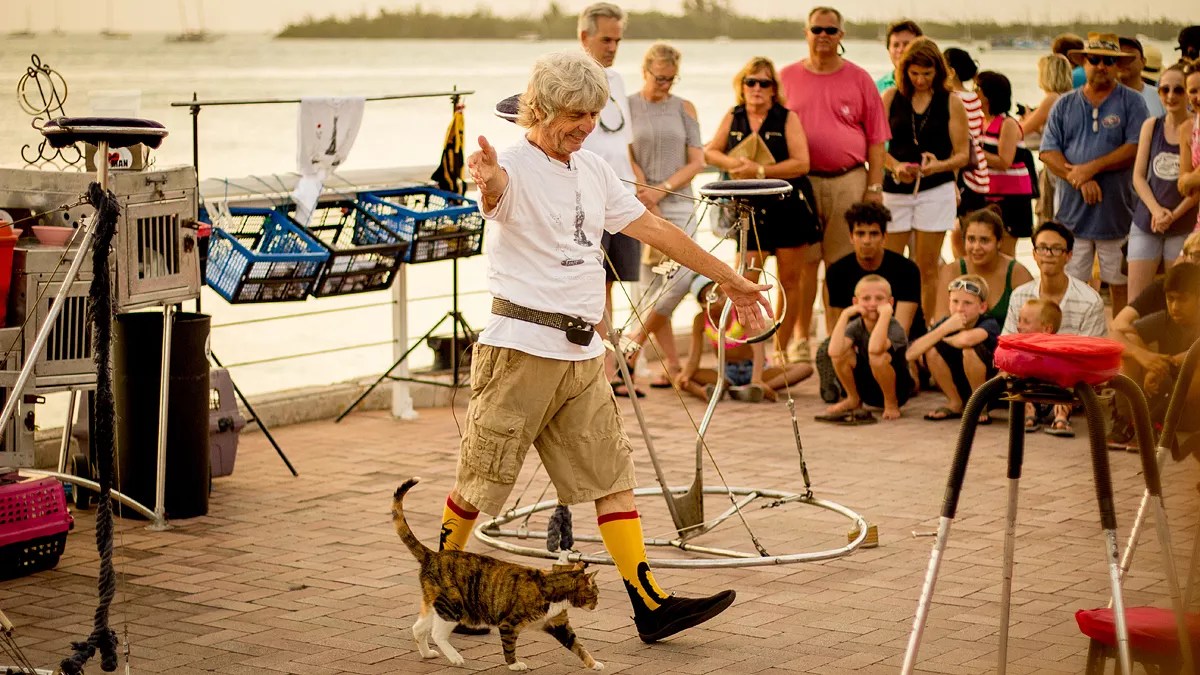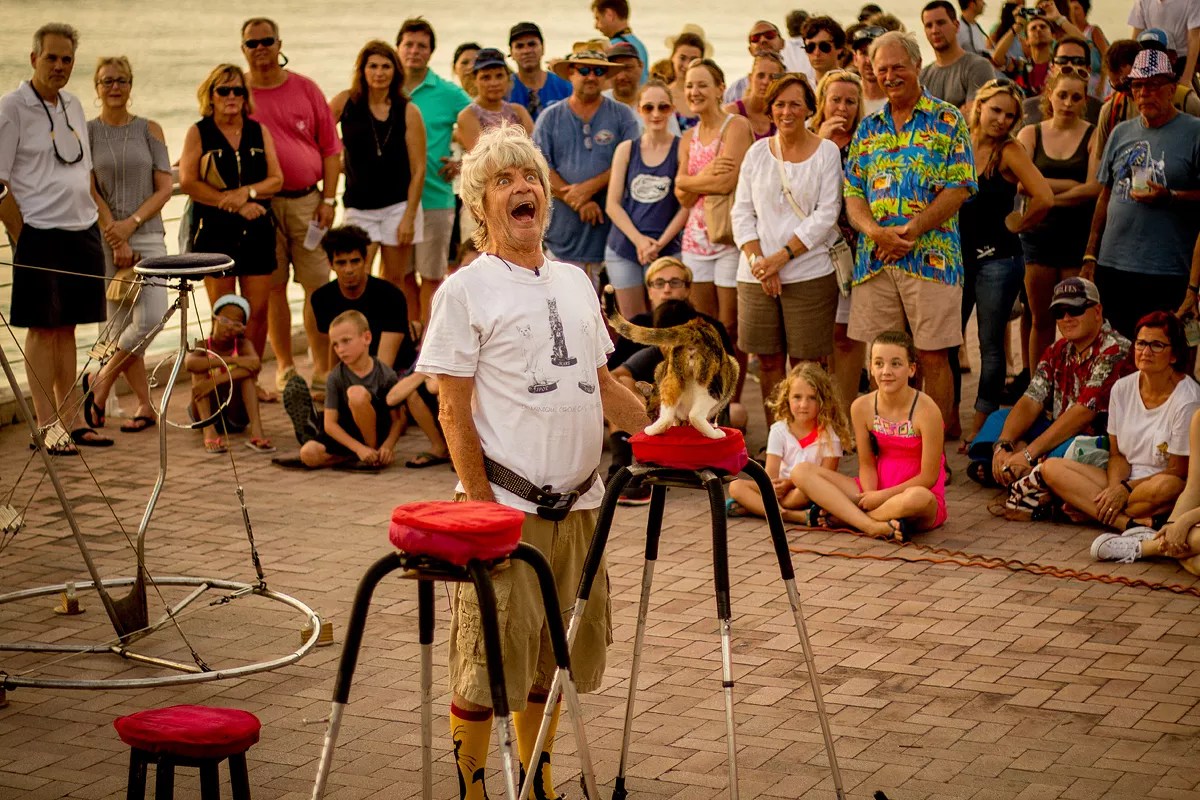
Audio By Carbonatix
An hour before sunset, a lanky man with long, disorderly gray hair rolls five metal cages to the end of a Key West pier about a block from Mallory Square. As sweat drips down his face, he stops and unloads six velvet-topped stools that gradually increase in height from three to five feet, one large speaker with the volume set to high, and sundry metal items such as small, shiny rings about half the size of his face. He also unloads three metal rods that create a makeshift clothes rack to hold T-shirts and socks available for purchase.
Six feet away, a group of young boys with sunburned faces watch the man. Their mildly confused parents stand close behind.
The gray-haired gentleman — 74-year-old Dominique Lefort — wears a white T-shirt covered with cat drawings, a black studded belt to restrain his healthy paunch, and yellow knee-high socks with spooky cartoon cats. He finishes setting up and then scurries among the clusters of onlookers, yelling in a loud, low-pitched French accent: “It’s about time!”
Miami, make your New Year’s Resolution Count!
We’re $14,000 away from reaching our $30,000 year-end fundraising goal. Your support could be what pushes us over the top. If our work has kept you informed, helped you understand a complex issue, or better connected you to your community, please consider making a contribution today.
He disappears down the pier toward the Margaritaville Resort. He reappears five minutes later pushing a cart stacked with three cages. But this time, they hold different cargo. “Toot, toot!” he howls with his hands thrown in the air. “Time to bring out the pussies!”
“Any dog people here?” Lefort screams, his tongue hanging from his mouth. “Go back to your seat!
“No filming!” he adds. “If you want to watch this again, you have to buy my DVD.”
Everything Lefort says and does could easily be reimagined in a cartoon. And his thick French accent prompts onlookers to cock their heads.
A few minutes later, he positions a thin balance beam between two of the velvet-topped stools. He removes a petite cat with small white paws from a cage and places it gently on the soft velvet. Without flinching, the feline leaps from one stool to another. “What a ballerina with Bugs Bunny legs!” Lefort says to the now-rapt crowd. Then the cat hops through a hoop about the size of her torso.
Before the feline returns to its cage, Lefort grabs the end of its tail and places his face just inches from the animal’s rear end. He lets out a long holler, poking fun at the crowd’s visible discomfort.
“He’s more of a show than his cats. You come for the cats, but you leave curious about this man.”
After a few more tricks with another member of his kitty crew, Lefort removes a slender black cat dressed in a pumpkin-orange Halloween shirt from a cage and places it at the bottom of a flimsy metal staircase. The cat climbs to the top and moves onto yet another of the velvet stools before glaring into the crowd, which has now grown to about 150 onlookers.
Lefort, his hair flowing in the wind, retreats a few steps and picks up a four-foot metal rod crowned with a three-foot ring. Seconds later, he places it on the ground and pours an entire container of lighter fluid onto the ring. Then he pulls out a match and lights the ring on fire. The cat on the stool seems to quake with fear and then pushes back on its haunches. The audience freezes.
Lefort, a Frenchman known to many as “Cat Man,” has developed an enormously popular pre-sunset show over three decades in Key West. Cats, which many people consider untrainable, jump long distances on command, exhibit amazing balance, and leap through flaming hoops. Pretty much anyone who has visited the continental United States’ southernmost point to ogle its spectacular sunset has seen him.
This is no small business. Between tips and sold merchandise, Lefort makes enough money to live comfortably with his eight-plus cats in a trailer on Stock Island, about five miles north of Mallory Square. Lefort says he has even earned enough to have sent his daughter through college at UCLA. (She declined to comment.)
Lefort, who himself sports an uncanny resemblance to a cat, is cagey about his background. Born in Paris, he was once a clown and even had a minor, nonspeaking role in 7 Fois… Par Jour (Seven Times a Day), a Canadian-Israeli comedy about an architect who suffers from excessive urges to have sex. He also claims to have been featured in the first-ever IMAX movie, Tiger Child, which premiered at Expo ’70 World’s Fair in Japan.
After living in Montreal for a time, Lefort showed up in Key West just as it was evolving from America’s end of the road into a sophisticated tourist town with a carefully tended, laid-back vibe. Indeed, a study of his background is a glance backstage in the Conch Republic — something like a look into Mickey Mouse’s dressing room.
“He’s more of a show than his cats,” says Key West tourist Paulie Bath, who has watched Cat Man for more than ten years. “You come for the cats, but you leave curious about this man.” Hundreds of people gather each night at sunset to watch Lefort and his cats perform next to the water in Key West. See more photos from Lefort’s Mallory Square cat show.
Just before sunset on Halloween night in 2006, Michael Patrick wrapped a straitjacket around his chest. The long-haired, well-muscled 55-year-old, nicknamed “Michael the Escape Artist,” walked to the edge of the Mallory Square pier and stood with his back to the water. Then he flipped into the 35-foot-deep harbor and disappeared.
“I heard a large splash and realized he was gone,” recalls Will Soto, a street entertainer who sports long, gray hair, a fuzzy mustache, and a right sleeve of tattoos. “I pulled off my shoes and dove in. There was this incredible current ripping through the channel, and I couldn’t find Michael anywhere.”
The Coast Guard, the city’s fire and police departments, and the Florida Fish and Wildlife Conservation Commission spent hours searching. “I started to look around, and I realized Patrick’s car and his cell phone were gone,” Soto says. “I remember thinking, He’s got to be alive.”
Around midnight, Soto returned home. A few minutes later, his phone rang. “How’d you like my trick?” a deep voice asked. It was Patrick.
“You’ve got to turn yourself in,” Soto answered. “Everybody is out crying and thinking you’re dead.”
It’s not only home to Lefort’s Cat Man, but it also helped transform the Conch Republic’s capital.
Patrick explained he had hired a diver to wait for him under the pier and remove the straitjacket. Then they swam a few blocks down. He added that he would reveal the secret of his stunt the following day.
But it didn’t work out that way. Patrick was arrested and jailed. He was later fined $60,000 for the massive search and spent 60 days in jail, according to a 2007 Associated Press report.
“He hasn’t been back to Key West since,” Soto says.
That was just one of the strange moments of entertainment at Mallory Square, a waterfront chunk of land that offers arguably the best view of the sunset in the Southeast United States. It’s not only home to Lefort’s Cat Man, but it’s also a literary and entertainment juggernaut that helped transform the Conch Republic.
Located less than a mile from the home of author and mariner Ernest Hemingway, Mallory Square was a favorite haunt of playwright Tennessee Williams, who wrote part of A Streetcar Named Desire in the town. Williams visited Mallory Square nightly in the 1940s to watch the sunset on his boat, according to Key West historian Tom Hambright. “Williams is credited with making [Mallory Square] real popular,” Hambright says. “After sunset, he and a few buddies would toast and then come back the next day. It all grew from there.”
Before Mallory Square gained its reputation as a tourist attraction, it was used as a commercial dock for large ships, according to Hambright. “It’s the best deep-water port around here,” he says. “There was a lot of seafood industry here too, but when it was set up for tourism, it changed.”

Will Soto arrived as a 30-year-old in the mid-’70s. Born in Chicago in 1946, he served as a radioman in the Navy and visited Key West in 1966 while in the service. The next year, he left the Navy and enrolled in Southern Illinois University to pursue art. Later, he returned to Key West as a sculptor.
“There were no rules when I first got here,” he says. “There was hardly any tourism, which meant there was no one to offend. People would come to drink, dance, and skinny-dip. We’d even do the limbo naked. I remember when Jimmy Buffett would sit on a bucket and play the guitar. The police didn’t really come down until it started to become a noticeable event. It’s hard to keep a party that good a secret.”
For years, the only performers in Mallory Square were a magician, a clown, two drummers, and Soto, who developed his entertainer persona through trial and error. He learned to walk across a razor-thin rope while throwing and catching sharp knives. “Mallory Square made us all feel good and comfortable,” Soto says. “People laughed with us, not at us.”
As the crowds grew, other street performers and merchants followed. “It used to be about just having fun,” Soto says. “No one went to make money, but now that’s how people make a living.”
In 1984, a small group of artists and performers, including Soto, created the Key West Cultural Preservation Society (CPS) to oversee the entertainment in Mallory Square. The show was nicknamed “Sunset Celebration.” From then on, all performers, artists, and food vendors were required to apply and demonstrate their skills. If accepted, small acts like one-person bands or magicians had to pay $5, while more accomplished performers, like Soto, were charged $15. The show was limited to two hours before and after sunset.
To preserve Sunset Celebration, CPS leases the Mallory Square dock from the City of Key West and uses the money from entertainers for support. The organization also has a $1 million insurance policy, Soto says.
“Mallory Square was one of the last great hippie parties,” Soto recalls. “People went there to drop out and get away from civilization. No one ever asked what your last name was or what you did for a living. It was just sort of about sex, drugs, and rock ‘n’ roll.”
Today, performers such as Reid Conklin, a slender 20-something with tattoos across his chest, thrills crowds by throwing knives and flaming torches high into the air. Dennis Riley, an older man with thin strands of salt-and-pepper hair, wears a knee-length frilled skirt while he plays a bagpipe. And almost every night, Rev. Bill Welzein, nicknamed “Bible Bill,” stands in white ankle-high socks tucked into worn sneakers and preaches the gospel.
At least three times a week, Soto, a 71-year-old juggler who has performed for more than 40 years, does his show like clockwork.
“Everyone is going to see the evolution of Mallory Square differently,” Soto says. “Some people think the commercialization ruined it… The town has gotten a lot more conservative, which squeezed a lot of funk and characters out. The cost of living has gone up a lot too. A lot of colorful people who created this place… couldn’t survive here anymore.”
Lefort, dressed in washed-out blue jeans, open-toed shoes, and a blue T-shirt one size too large, strolls into Blue Heaven, a funky Key West restaurant two miles from Mallory Square, on a recent Wednesday afternoon. Inside, he removes a pair of large black women’s sunglasses.
As he roams the restaurant, customers smile at him. A slender man wearing a Key West T-shirt and a baseball cap, seconds away from biting into a fish sandwich, stops and whispers, “Look, it’s that crazy cat man.”
Lefort sits down at a table and begins speaking, mostly in that deep and intense French accent, about his childhood in Brittany, a region in northwest France. It wasn’t easy to be there in the years after World War II, he says.
As a boy, he says, he dreamed of becoming a clown. The grim years of war, which decimated his homeland, inspired him to dedicate his life to making people laugh. But he soon learned that to be a clown, one needed wisdom that only came with age. “You couldn’t be a clown if you were young,” he says.
In school, he studied drama, opera, modern dance, and pantomime. As a teenager, he followed strangers on the street to try to mimic their gaits and gestures.
“Each person moves in a different way,” he says. “If you want to play a character, you have to go inside of them intellectually. When I would follow people, I tried to get an idea of how they feel, and to feel that myself.”
Those were the years when perhaps the greatest mime of all time, Marcel Marceau, was beginning his career in Paris. At first, Marceau entertained thousands of troops after the liberation of Paris. Later, he founded a world-renowned school of pantomime.
At age 16, Lefort began studying Russian theater practitioner Konstantin Stanislavski’s method of acting, in which an actor transforms into a character physically, vocally, and emotionally. It’s what helped created the Cat Man personality, Lefort says.
“My show is a play,” he says. “Over my whole life, I have played different characters. I like to be more than just Dominique.”
After completing his studies in Paris, he signed a contract with an improvisational acting troupe that did puppetry and mime. That led him to London for a few years and eventually Montreal. When Lefort wasn’t acting, he donned a bright-orange curly-haired wig and a round red nose to entertain crowds. His character was named “Rou Dou Dou.” He twisted balloon creatures, yelled, and joked with onlookers.
Eventually, he quit the acting company and met a woman, whom he declines to name. Soon they had a daughter, Vanessa. While still tiny, she was given a cat. Lefort formed an immediate bond with the animal. “[Vanessa] kept pulling its tail and pushing it around,” he says. “So that cat would come to me for protection. I started training the cat and figured people would be entertained by it.”
“These cats are my family. Seeing the look on people’s faces melts my heart.”
Soon he began to incorporate Vanessa’s cat into his clown show, training it to jump from one stool to another or to latch onto his backside with its claws. Fans loved it.
But sometime later, Vanessa and her mother moved to California, and Lefort decided to leave Montreal for Orlando, where he scored a gig at Disney World’s Pleasure Island. It was there he traded in his clown costume for a nightly cat show at the resort’s Rock N Roll Beach Club. After a spontaneous vacation to Key West, where Lefort experienced Mallory Square’s street performance culture for the first time, he decided to move south. He began performing nightly as Cat Man in the early 1980s, rarely taking time off.
“One time I took three days off, and I felt sick from not performing,” he says. “The cats hate not doing it too. I need to be out there doing the shows.”
By the early ’90s, Lefort had become the main attraction of Mallory Square, drawing tourists and townies to his daily sunset performance. He was even featured on Late Night With David Letterman. “I never wanted to be a star,” he says. “I did not become an actor to be a star. I need to play other characters in my life; that’s why I do this.”
He says the cats are what keep him coming back to the pier every night.
“These cats are my family,” he says. “Seeing the look on people’s faces when they jump through the hoops just melts my heart.”
In 1991, the Orlando Sentinel reported animal activists’ claims that Lefort starved and mishandled his cats. But several investigations turned up no evidence. “You have to treat [the cats] with respect,” Lefort says, explaining that “training can take anywhere from a month to a year.”
About ten years ago, Lefort’s cat show moved from Mallory Square to the pier adjacent to the Westin Hotel, which is now owned by Margaritaville. The resort also let him store his equipment, including the scratched-up metal cages, stools, and props, which he spent months designing and building himself.
When it comes to talk of his own family, Lefort’s cheerful, clown-like face turns dour. He refuses to speak about anything that is not related to “Dominique the Cat Man.” (“You’re going to have a hard time with me,” he says.) What he will say, however, is that his work as Cat Man helped fund his daughter’s studies at UCLA and later Cornell, where she majored in physics. He refers to Vanessa as a scientist, though she is currently a commercial litigation attorney in Los Angeles.
Neither Vanessa nor an ex-wife, Karen, would talk much about him. Karen and Dominique married in 1999 and divorced in 2004. She changed her first name to “Paris” sometime after their divorce. “Dominique is someone you will never really know,” she said in a text message. “It is not what he wants.”
Back at the show, as the cat in the orange Halloween shirt prepares to leap, the upper half of the ring is engulfed in flames. The finale is seconds away. But with each gust of wind, the fire fades.
“Stay where you are!” Lefort screams.
Then the cat jumps through the ring, landing on an adjacent velvet stool. She turns quickly and leaps back through the ring.
Lefort smiles and waves the now-flameless ring in the air. “Tadaaaah!” he howls.
The cat scurries back into a cage as Cat Man announces in that familiar accent, “Thank you, thank you. Another show in 15 minutes, after sunset.”
Susie Becker, a middle-aged woman with cotton candy-like blond hair, is there peddling lemonade to passersby. She remembers the first time she saw Cat Man. It was a night in 1986, the year she started selling on the pier. “We’ve all watched him for years, but most of us don’t really know anything about him,” she says. “All we know for sure is he does his wild cat show.”
Nearby, Dave Del Rosso, wearing jet-black sunglasses and a worn baseball cap, sells fruit juices at a similar stand. “It’s been years and there is still a draw,” he says. “People seem to love the cats. There’s something about them.”
Randy and Kristy Erdman have been watching Lefort’s show for 20 years. Their daughter Emily, who is now 18, grew up seeing the performance at least once a year. “At first you think he’s a crazy whack job,” Randy says. “But then you see him in between shows and the way he treats his cats, and you realize he’s a normal guy.”
As the crowd disperses, some fans approach Cat Man for an autograph. Others throw a few dollars into a shiny red garbage can that Lefort uses for tips. A few steps away, plastic cartons hold performance swag such as shirts, DVDs, and women’s thongs stitched with the word “pussy.”
“I never take a day off,” Lefort asserts. “I need to be out there doing the shows.”
Does he plan to spend the rest of his life as Key West’s Cat Man? “The winds bring you here and there,” he says. “You need to be comfortable with extending your wings and just going. Who knows where I’ll go?”
Stephanie Michals contributed to this story.